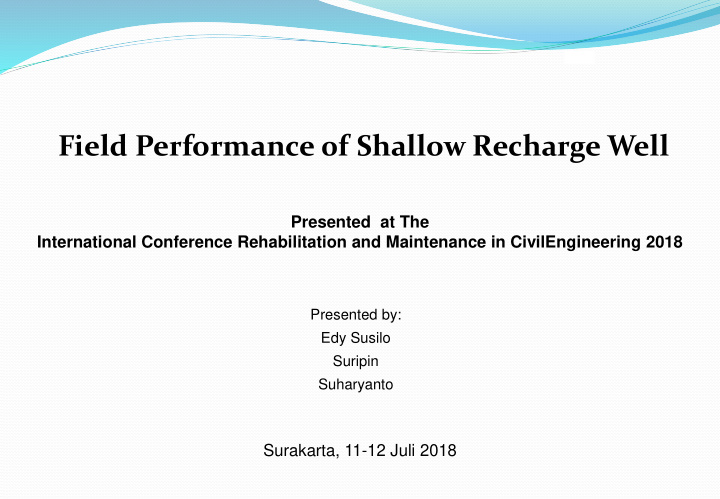



Field Performance 0f Shallow Recharge Well Presented at The International Conference Rehabilitation and Maintenance in CivilEngineering 2018 Presented by: Edy Susilo Suripin Suharyanto Surakarta, 11-12 Juli 2018
Background • Changes In Watershed Response to Rain 1 Population Land Use • Increased Flood Growth Change Discharge 2 • Decrease Ground Water 3
Background Regulation number 13/2017 described in the Regional Spatial Plan is required to apply zero delta Q policy Article 99 (3) Zoning regulations for water catchment areas prepared with attention to: a. limited space utilization for cultivation activities that are not built has a high ability in holding rainwater runoff; b. provision of absorption wells and / or reservoirs on existing built land; and c. application of principle z, ero delta Q policg against every cultivation activity that awakens submitted his permission
Background Applied technical calculations for the reduction of peak flood: How many recharge wells are needed? How much is the diameter? How deep is it? It is necessary to calculate the number and dimensions of the absorption pool in a practical and easier way
Literature Review Some calculations of recharge wells used are Horton f t = f c + (f o – f c ).e -kt This formula is not entirely justifiable (Elizar, 2011, Agus, 2005) .
Indonesian National Standard (SNI), HMTL-ITB formulas Ministry of Public Work
Ministry of Forestry Association for Rainwater Storage and Infiltration Technology (ARSIT) These formulas are not appropriate dimensional analysis principles (Sunjoto, 2011)
Minnesota Urban Small Sites BMP Manual : Infiltration Trench This formula is for rainwater storage building, it is not a formula of rainwater absorption because it is not influenced by soil ability parameters for water impregnation. (Sunjoto, 2011) Sunjoto This formula is appropriate with dimensional analysis, but it is not easy to use because there is variable not easy to be measured
The basic formula of absorption in the soil was proposed by Forchheimer (1930) q = FKh 0 = absorption recharge (m 3 / sec) qo F = geometric factor of recharge wells (m) K = permeability of soil (m / sec) h = water depth (m)
According to Darcy's law, the flow discharge through a cross section A, the hydraulic conductivity of soil K, and the length of flow L are formulated by equation (Fetter, 1994): dh = Q KA dl dh Q = K A dl The quantities Q, A, K, and dh for the recharge well are all clearly measurable, but dl is unknown in length. Then the above equation can be written: Q = f ( K , h ) A H : the water level in the well, Q/A : the absorption recharge per unit area obtained from the measurement
Methodology
Results and Discussion Soil Characteristics Percentage of Soil Water Content Soil Permeability No. Passing Sieve # 200 (cm/hour) (%) (%) 1. 26,43 50,45 25,20 2. 36,18 66,20 4,68 3. 37,27 51,33 3,96 4. 12,37 59,15 3,06 5. 22,31 57,03 2,84 6. 28,29 56,48 1,40 With relatively small soil water content, then before the observation of the infiltration, wellbore filled with water until the condition is saturated more or less for 1 hour. Percentage passing through the No. 200 sieve more than 35%, according to AASHTO criteria or more than 50% according to the others, classified as silt-clay materials. According to Fetter (1994) cohesive sediment with a low conductivities, permeability is measured by a falling head
Graph Dimensions of Recharge Wells
The steps of using the graph are as follows: 1. Investigate the soil permeability of the well location plan 2. Calculate the discharge that will be reduced by a recharge well (Qr) based on hydrological and hydraulic analysis 3. Plan the number of wells to be used (n) 4. Calculate the absorption recharge of a well (Q = Qr / n) 5. Plan the well diameter to be used 6. Calculate the discharge value per unit area (Q / A) 7. Drag the vertical line upward until intersected with the appropriate soil permeability curve. If nothing is exactly the same, interpolation can be done. 8. Drag the horizontal line to get the required depth of well. 9. If no suitable recharge well dimension of technical standard, either diamaeter or depth, then repeat again from step number 3
Graph Dimensions of Recharge Wells For Example: We need to decrease: 0,50 m3/sec We use diameter well 1,00m So Q/A = 0,06 cm/sec If K=25,2 cm/hour → H=70 cm If K=4,68 cm/hour → H=110 cm If K=3,96 cm/hour → H=120 cm If K=3,06 cm/hour → H=138 cm etc
Conclusion 1. The relation between the recharge per unit of well cross- sectional area to water height is in the form of parabolic curve 2. Recharge wells are proportional to cross-sectional area and soil permeablity 3. Absorption of recharge wells with nonperforated walls is relatively low, so it needs to be innovated recharge wells with greater absorption.
Recommend
More recommend